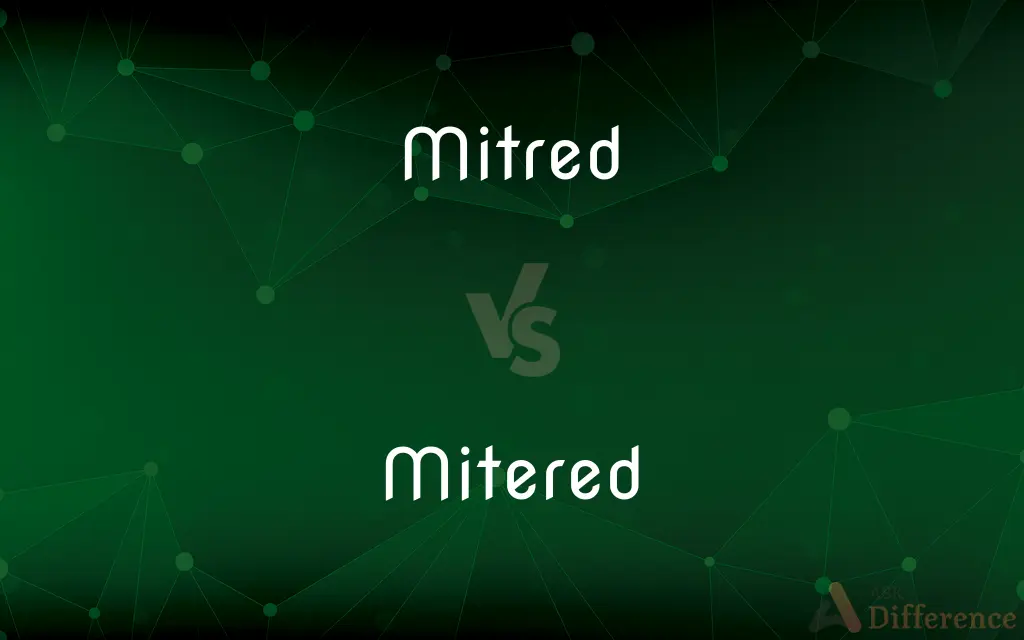Mitred vs. Mitered — What's the Difference?
By Fiza Rafique & Urooj Arif — Updated on April 20, 2024
"Mitred" and "mitered" refer to the same concept—the joining of two pieces at an angle, typically 45 degrees, to create a corner, such as in picture frames or woodworking. "Mitred" is the British spelling, while "mitered" is the American spelling.

Difference Between Mitred and Mitered
Table of Contents
ADVERTISEMENT
Key Differences
When discussing angles in carpentry or framing, both "mitred" and "mitered" describe the technique of cutting each of two parts to an angle that fits together to form a corner, typically at 90 degrees. The main difference lies in regional spelling preferences: "mitred" is commonly used in British English, whereas "mitered" is preferred in American English.
In woodworking, a "mitred" or "mitered" joint involves cutting the ends of two pieces of wood so that they join together seamlessly, often used for aesthetic purposes as it hides the end grain, providing a clean and attractive finish. The terminology varies by region but the technique and purpose are identical.
"Mitred" corners are often seen in picture frames, door frames, and window trim, enhancing the decorative appeal by aligning patterns like stripes or different wood grain textures seamlessly. "Mitered" corners serve the same purpose in the United States, reflecting a simple difference in spelling across English-speaking countries.
The use of "mitred" versus "mitered" can also be seen in sewing and fabric work, where edges are angled and joined to create a neat corner, commonly used in the edges of tablecloths or the corners of quilts. Whether one uses "mitred" or "mitered" again depends largely on whether they are adhering to British or American English conventions.
Both terms are used interchangeably in global woodworking and crafting discussions, with the understanding that they refer to the same process. The choice of term may indicate the writer's or speaker's national origin or the intended audience's dialect.
ADVERTISEMENT
Comparison Chart
Spelling
British English
American English
Usage
Common in the UK, Commonwealth
Common in the USA
Industry
Woodworking, carpentry, sewing
Woodworking, carpentry, sewing
Joint Type
Angled joint for corners
Angled joint for corners
Visual Appeal
Hides wood grain, cleaner look
Hides wood grain, cleaner look
Compare with Definitions
Mitred
British English spelling used in carpentry and fabric work.
The carpenter admired the mitred edges of the wooden table.
Mitered
Same as mitred, indicating an angled joint between two parts.
The mitered corners of the picture frame were cut to precise 45-degree angles.
Mitred
Refers to an angle of two parts that combine to form a corner, especially at 90 degrees.
He carefully measured the frame to make sure it was perfectly mitred.
Mitered
Applies to various materials, including wood, metal, and fabric.
The metal frame was mitered at each end to ensure a tight fit.
Mitred
Utilized to create a seamless corner without visible end grain.
The mitred corners on the quilt added a neat, professional finish.
Mitered
Often used in contexts where a clean, attractive corner is needed.
Mitered edges are essential for a polished finish in carpentry.
Mitred
Preferred terminology in regions following British English standards.
In her sewing tutorial, she explained how to sew a mitred corner.
Mitered
Indicates American English usage in tutorials or product descriptions.
The DIY book featured a chapter on how to create mitered joints for home furniture.
Mitred
Enhances the alignment of patterns or textures at the corner.
The wallpaper was mitred at the corners to maintain the pattern flow.
Mitered
American English variant, common in the US.
His woodworking project included detailed instructions on making mitered cuts.
Mitred
Wearing an abbot's or bishop's mitre.
Mitered
The liturgical headdress and part of the insignia of a Christian bishop. In the Western church it is a tall pointed hat with peaks in front and back, worn at all solemn functions.
Mitred
Having a mitre joint.
Mitered
A thong for binding the hair, worn by women in ancient Greece.
Mitered
The ceremonial headdress worn by ancient Jewish high priests.
Mitered
A miter joint.
Mitered
The edge of a piece of material that has been beveled preparatory to making a miter joint.
Mitered
A miter square.
Mitered
To bestow a miter upon.
Mitered
To make (two pieces or surfaces) join with a miter joint.
Mitered
To bevel the edges of for joining with a miter joint.
Mitered
To meet in a miter joint.
Mitered
Simple past tense and past participle of miter
Common Curiosities
Can both "mitred" and "mitered" be used interchangeably in academic or professional writing?
Yes, but it's best to stick to one spelling variant based on the regional audience: "mitred" for British English and "mitered" for American English.
Which is more durable, a mitred or a butt joint?
Mitred joints, while aesthetically pleasing, are not always as strong as butt joints unless reinforced, as they tend to focus stress at the joint's angle.
How do I choose between using "mitred" and "mitered"?
Choose based on the primary audience's location: use "mitred" for a British audience and "mitered" for an American audience.
Are mitred/mitered joints only used in woodworking?
No, these joints are also common in metalworking, fabric crafts, and various types of construction and DIY projects.
Do mitred/mitered corners add structural strength?
While mitred/mitered corners are more aesthetically appealing, they generally do not add structural strength compared to other types of joints and may require additional reinforcement.
What are some common mistakes to avoid when making mitred/mitered cuts?
Common mistakes include not measuring angles accurately, not securing the material firmly while cutting, and failing to check the tool's settings.
What is the best way to ensure alignment in mitred/mitered joints?
Using a miter gauge or a jig can help ensure that cuts are made at the correct angle and that the pieces align properly when assembled.
How does wood grain orientation affect the strength and appearance of mitred/mitered joints?
Aligning the wood grain directionally can influence both the strength and the aesthetic continuity of the joint, especially visible in stained or clear-coated projects.
Is there a difference in technique between mitred and mitered joints?
No, the technique is the same; the difference lies solely in the regional spelling.
Are there specific finishes recommended for mitred/mitered joints to enhance their appearance?
Sanding the joint smoothly before applying finish and using stains or paints that accentuate the joint design can enhance the appearance of mitred/mitered joints.
Can mitred/mitered joints be used in load-bearing structures?
Typically, mitred/mitered joints are not recommended for load-bearing structures without proper support because the joint mainly provides aesthetic value and not strength.
What tools are required for making a mitred or mitered joint?
Essential tools include a miter saw, which can be either manual or powered, to ensure precise angular cuts.
How can I improve the strength of a mitred/mitered joint?
Strength can be enhanced by adding dowels, splines, or biscuits within the joint, or by using appropriate adhesives that bond the materials effectively.
What are the environmental considerations when working with mitred/mitered joints?
Using sustainable wood sources and environmentally friendly adhesives and finishes can reduce the environmental impact when constructing mitred/mitered joints.
What types of projects are most suitable for using mitred/mitered joints?
These joints are ideal for projects where aesthetics are important, such as picture frames, window casing, and decorative trims.
Share Your Discovery

Previous Comparison
Larceny vs. Burglary
Next Comparison
Grandpa vs. GranddadAuthor Spotlight
Written by
Fiza RafiqueFiza Rafique is a skilled content writer at AskDifference.com, where she meticulously refines and enhances written pieces. Drawing from her vast editorial expertise, Fiza ensures clarity, accuracy, and precision in every article. Passionate about language, she continually seeks to elevate the quality of content for readers worldwide.
Co-written by
Urooj ArifUrooj is a skilled content writer at Ask Difference, known for her exceptional ability to simplify complex topics into engaging and informative content. With a passion for research and a flair for clear, concise writing, she consistently delivers articles that resonate with our diverse audience.














































